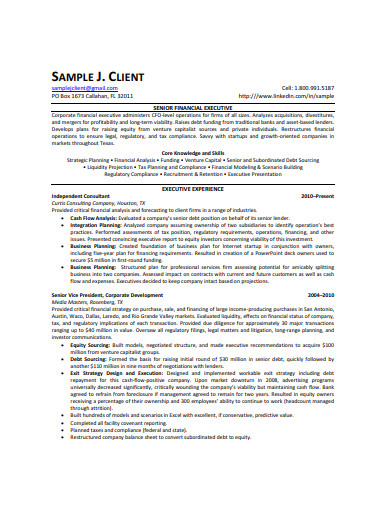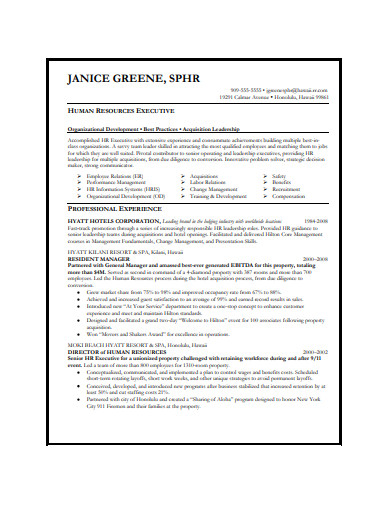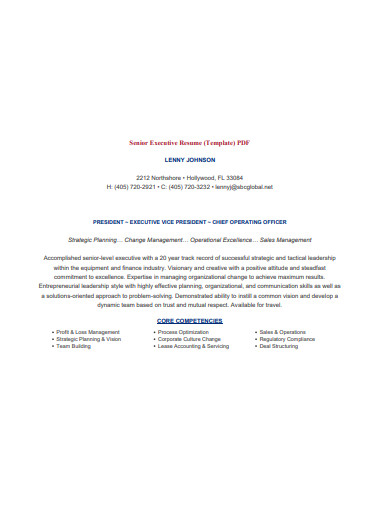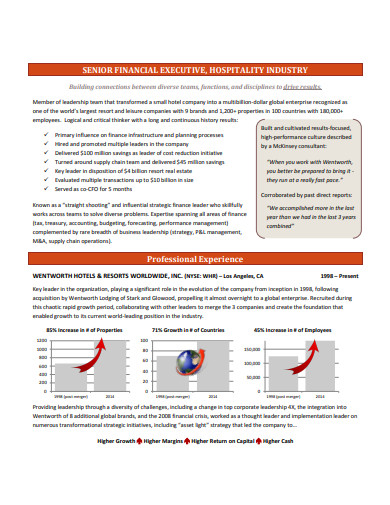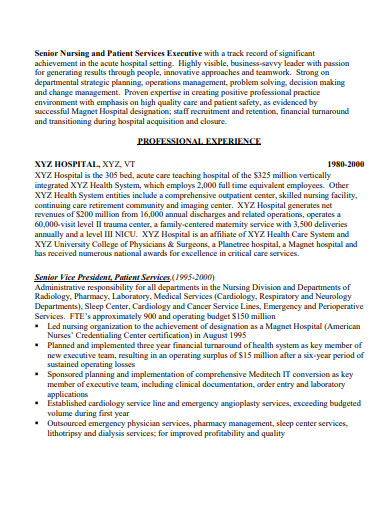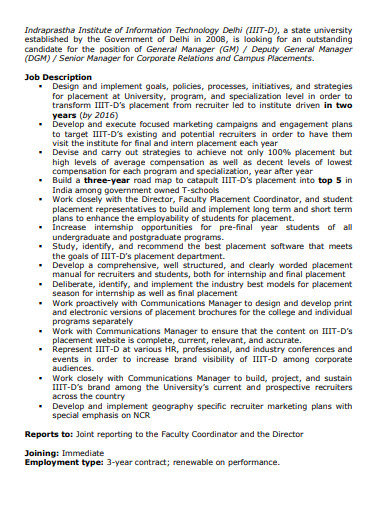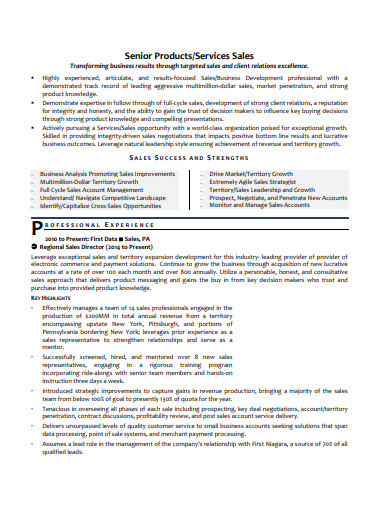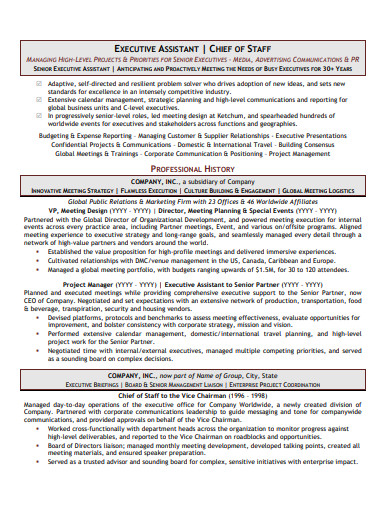10+ Senior Executive Resume Examples to Download
The senior management of a company is a group of experienced professionals that is responsible for the different aspects of strategic business development, such as marketing and other operations. Many employees aspired to become a part of such a team. However, the career venture requires extensive work experience. Furthermore, the process of being onboarded for the team’s open positions is the same as any other employment post. The required application documents, too, are very much alike, including the resume, which we all know is an effective tool that presents a summary of one’s credentials and their professional objectives. So, get yourself exposed to our highly reliable 5+ Senior Executive Resume Examples that are available in PDF, Microsoft Word, Pages, Photoshop, Publisher, and InDesign file formats.
10+ Senior Executive Resume Examples
1. Free Senior Executive Resume Template
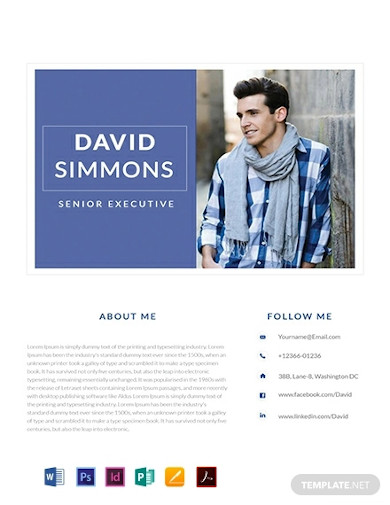
2. Senior Financial Executive Resume
3. Senior Human Resources Executive Resume
4. Senior Executive Resume Format
5. Senior Human Resources Director Executive Resume
6. Senior Executive Resume Example
7. Senior Financial Executive Resume Example
8. Senior Nursing and Patient Services Executive Resume
9. Senior Placement Executive Resume
10. Senior Sales Executive Resume Example
11. Sample Senior Executive Assistant Resume
What Is a Senior Executive Resume?
A senior executive resume is an application document that outlines an applicant’s educational and professional background, as well as his or her expertise and qualities that fit a senior executive position. According to Ginger Software, resumes help applicants create an advantageous first impression on potential employers. The same source cited that such documents’ respective contents assist employers in easily grasping how the applicants’ histories shape up the future of their companies. Therefore, it is safe to say that a resume is an essential paperwork, especially when applying for a high-ranking job position, such as a senior executive.
You as a Product
Employment or entrepreneurship is undeniably necessary for an individual’s sustainability. It is also beyond doubt that marketing plays an equally important role for both angles. The majority of us are laid down in employment, and marketing on this aspect is more on self-promotion than hyping products and services. Another way of putting it is to think of yourselves as the product or service with employers as potential clients. Frances Trought wrote in his book entitled Brilliant Employability Skills that marketing is the very core of a job hunt’s success and not just a mere business activity.
How To Create a Senior Executive Resume
High-ranking job positions have high standards, not just on the credibility of applicants but also on the way they present their resumes. Additionally, there are many things that need to be considered when creating such a document effectively. Below, you will be given an outline of the steps that you have to take to create a good representation of yourself through your resume.
1. Choose a Resume Structure
There are three types of resume, namely chronological, functional, and combination. Each type has a different structure. A chronological resume gives more importance to the professional experiences and achievements, making it the perfect format for prolific applicants. Meanwhile, a functional resume focuses more on the capabilities and experience. It is often used by applicants who have irrelevant past job experiences, employment intermission, and for those who look to change career paths. The last type, combination resume, has combined qualities with that of a chronological and functional resume. It is the applicants with diversified work histories who typically use this type.
2. Begin With a Header
Once you have decided on what type of resume structure you will be adopting, then start creating your resume by setting the header. The header of a resume must include your complete name, contact number, and email address. As an aspiring senior executive, it is your responsibility to make sure that the contact number you are giving out is active, and the email contains a professional name.
3. Introduce Your Purpose
With the header set, proceed in giving out your introductory statements. This can be done in two to three sentences. In doing so, make sure to mention the reasons why you want to become a senior executive and why you chose the company as your future employer. In addition, try providing a brief summary of your resume’s content.
4. List Qualifications
After your introduction, the next step is to list all the qualifications that you have to be employed as a senior executive. The lists must be categorized into four, including your skills inventory, experiences, the qualities you have in a working environment, and the relevant activities you took part in.
5. Present Education and Training
Your education and all the pieces of training you took plays a big role in your resume. These factors are one of the key indicators of how knowledgeable an applicant is. Providing a role-specific training inventory not only qualifies you from becoming a senior executive but also gives employers a hint of how dependable you are if left with less supervision.
6. Showcase Awards or Certificates
For most employers, there is nothing more effective in putting candidates ahead of the line than their list of awards and training certificates. If you plan on showcasing the list of these documents, then you have to make sure to include the actual documents among your job application paperwork.
FAQs:
1. How long should my resume be?
Make your resume in one to two pages. Recruiters or employers have long piles of resumes coming from other applicants. So, it is important to make yours easy to scan. At the same time, you also have to ensure its completeness of relevant information.
2. How do I explain my employment gaps?
Explaining the employment gaps you presented in your resume is easy. All you have to do is recall all the activities you got involved in the span of your gaps. These activities may be voluntary works and freelancing works.
3. Can I make my resume appealing even without any working experience?
If you do not have any working experience yet, then the best strategy to make your resume appealing to employers is to advance the skills and qualities that you have developed in your studies. Another way is to enthusiastically present your personal summary.
It has been established that high-ranked job openings require good credentials. However, every strict process, such as in employment, has a loophole. With the identification of the different types of resumes, prolific people and people with less job experience alike have been given equal chances to get any position they want. Then again, successful employment all goes down to the applicants’ creativity and preparedness.



